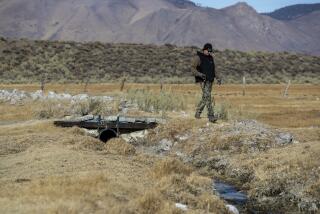Nicaragua Strike Ends in Labor Victory : Settlement: Workers win most demands, including pay hikes and compensation for discharged employees.
- Share via
MANAGUA, Nicaragua — Striking members of opposition Sandinista labor unions began returning to their jobs Thursday after President Violeta Barrios de Chamorro’s government yielded to most of their demands to settle a destructive work stoppage.
Workers began replacing street paving stones that were used to build barricades, and businesses reopened in this capital city. Six people were killed in clashes during the 10-day strike that tested the stability of Chamorro and her government, in office since April 25.
The government’s announced settlement with the National Workers’ Front, a pro-Sandinista labor federation that called the strike, grants 43% pay raises this month, with another increase to be paid in August. The amount of the second raise is still to be determined.
The agreement also requires that compensation be paid to 800 employees fired after April 26. State jobs will be reclassified in September, and a new minimum-wage law will be established.
The strikers also forced Chamorro’s conservative government to back down on a key part of its plan to return Nicaragua to a free-market economy: the return to their owners of lands confiscated after the leftist Sandinistas took power in 1979.
Workers and students will once again ride public transportation free of charge, a privilege granted by the Sandinistas and recently suspended by the new government to save money.
The government also agreed to create a commission of government and National Workers’ Front representatives to discuss government investment in state-owned textile, metalworking and construction companies. The talks are to begin Monday.
The creation of the commission appeared to be a response to the front’s demand for a role in making economic policy.
In Washington, State Department deputy spokesman Richard Boucher said the Bush Administration is pleased that the strikes have ended. But he assailed Sandinista officials, saying they have been unwilling to grant the government the breathing spell it needs to get desperately needed economic reconstruction under way.
The strike began July 2 and grew into the biggest challenge to Chamorro since the Sandinistas, in power nine years, were voted out of office. Since losing elections in February to Chamorro’s National Opposition Union, the Sandinistas have said they would “rule from below.”
The unions claimed that 90,000 government and state-industry employees joined the walkout. It was the second time since she took office that the Sandinistas have brought public services to a halt in an attempt to force pay raises and modifications in Chamorro’s plans to cut public spending, sell off state-owned enterprises and return to capitalism the socialist-oriented economy built by the Sandinistas.
Traffic began returning to normal here Thursday, but vehicles had to creep around potholes, dislodged paving stones and rubble left behind by barricades and fires that filled the streets during three days of disturbances.
The unions called off street disruptions Wednesday to persuade the government to negotiate, but gunfire could be heard in the city throughout Wednesday night and early Thursday. There were no reports of new casualties.
Earlier, at least six people were reported killed and 100 injured in fighting between strikers and government supporters.
The government had declared the strike “illegal, illegitimate and non-existent” and threatened to fire those who took part. Most present government employees received their posts during Sandinista rule.
More to Read
Sign up for Essential California
The most important California stories and recommendations in your inbox every morning.
You may occasionally receive promotional content from the Los Angeles Times.













